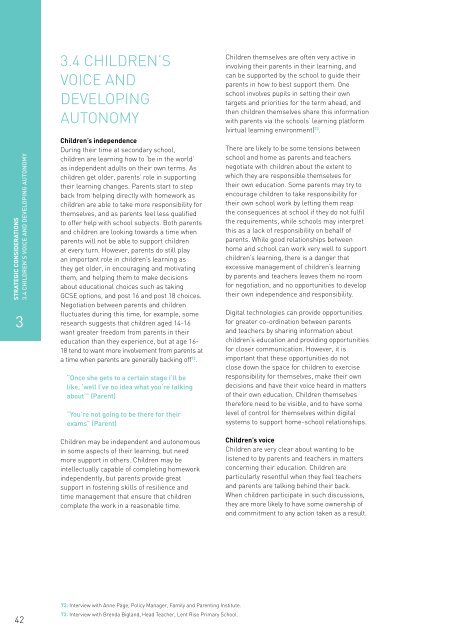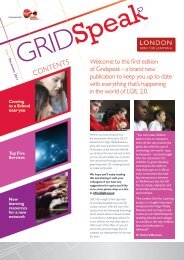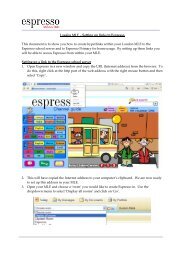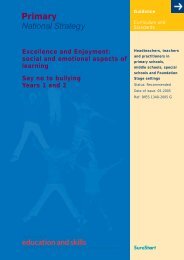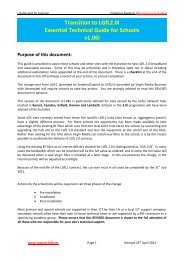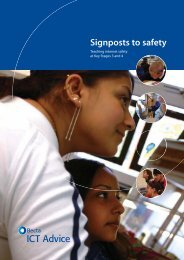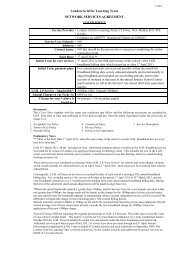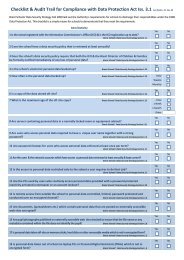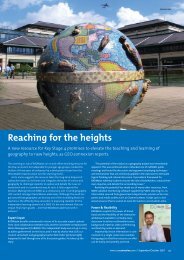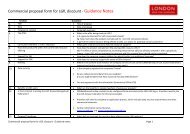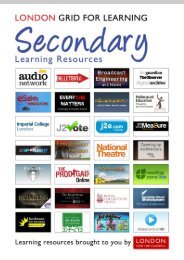Developing the home-school relationship using digital ... - Futurelab
Developing the home-school relationship using digital ... - Futurelab
Developing the home-school relationship using digital ... - Futurelab
- No tags were found...
Create successful ePaper yourself
Turn your PDF publications into a flip-book with our unique Google optimized e-Paper software.
STRATEGIC CONSIDERATIONS3.4 CHILDREN’S VOICE AND DEVELOPING AUTONOMY33.4 CHILDREN’SVOICE ANDDEVELOPINGAUTONOMYChildren’s independenceDuring <strong>the</strong>ir time at secondary <strong>school</strong>,children are learning how to ‘be in <strong>the</strong> world’as independent adults on <strong>the</strong>ir own terms. Aschildren get older, parents’ role in supporting<strong>the</strong>ir learning changes. Parents start to stepback from helping directly with <strong>home</strong>work aschildren are able to take more responsibility for<strong>the</strong>mselves, and as parents feel less qualifiedto offer help with <strong>school</strong> subjects. Both parentsand children are looking towards a time whenparents will not be able to support childrenat every turn. However, parents do still playan important role in children’s learning as<strong>the</strong>y get older, in encouraging and motivating<strong>the</strong>m, and helping <strong>the</strong>m to make decisionsabout educational choices such as takingGCSE options, and post 16 and post 18 choices.Negotiation between parents and childrenfluctuates during this time, for example, someresearch suggests that children aged 14-16want greater freedom from parents in <strong>the</strong>ireducation than <strong>the</strong>y experience, but at age 1618 tend to want more involvement from parents ata time when parents are generally backing off 72 .“Once she gets to a certain stage I’ll belike, ‘well I’ve no idea what you‘re talkingabout’” (Parent)“You’re not going to be <strong>the</strong>re for <strong>the</strong>ir exams” (Parent) Children <strong>the</strong>mselves are often very active ininvolving <strong>the</strong>ir parents in <strong>the</strong>ir learning, andcan be supported by <strong>the</strong> <strong>school</strong> to guide <strong>the</strong>irparents in how to best support <strong>the</strong>m. One<strong>school</strong> involves pupils in setting <strong>the</strong>ir owntargets and priorities for <strong>the</strong> term ahead, and<strong>the</strong>n children <strong>the</strong>mselves share this informationwith parents via <strong>the</strong> <strong>school</strong>s’ learning platform(virtual learning environment) 73 .There are likely to be some tensions between<strong>school</strong> and <strong>home</strong> as parents and teachersnegotiate with children about <strong>the</strong> extent towhich <strong>the</strong>y are responsible <strong>the</strong>mselves for<strong>the</strong>ir own education. Some parents may try toencourage children to take responsibility for<strong>the</strong>ir own <strong>school</strong> work by letting <strong>the</strong>m reap<strong>the</strong> consequences at <strong>school</strong> if <strong>the</strong>y do not fulfil<strong>the</strong> requirements, while <strong>school</strong>s may interpretthis as a lack of responsibility on behalf ofparents. While good <strong>relationship</strong>s between<strong>home</strong> and <strong>school</strong> can work very well to supportchildren’s learning, <strong>the</strong>re is a danger thatexcessive management of children’s learningby parents and teachers leaves <strong>the</strong>m no roomfor negotiation, and no opportunities to develop<strong>the</strong>ir own independence and responsibility.Digital technologies can provide opportunitiesfor greater co-ordination between parentsand teachers by sharing information aboutchildren’s education and providing opportunitiesfor closer communication. However, it isimportant that <strong>the</strong>se opportunities do notclose down <strong>the</strong> space for children to exerciseresponsibility for <strong>the</strong>mselves, make <strong>the</strong>ir owndecisions and have <strong>the</strong>ir voice heard in mattersof <strong>the</strong>ir own education. Children <strong>the</strong>mselves<strong>the</strong>refore need to be visible, and to have somelevel of control for <strong>the</strong>mselves within <strong>digital</strong>systems to support <strong>home</strong>-<strong>school</strong> <strong>relationship</strong>s.Children may be independent and autonomousin some aspects of <strong>the</strong>ir learning, but needmore support in o<strong>the</strong>rs. Children may beintellectually capable of completing <strong>home</strong>workindependently, but parents provide greatsupport in fostering skills of resilience andtime management that ensure that childrencomplete <strong>the</strong> work in a reasonable time.Children’s voiceChildren are very clear about wanting to belistened to by parents and teachers in mattersconcerning <strong>the</strong>ir education. Children areparticularly resentful when <strong>the</strong>y feel teachersand parents are talking behind <strong>the</strong>ir back.When children participate in such discussions,<strong>the</strong>y are more likely to have some ownership ofand commitment to any action taken as a result.4272. Interview with Anne Page, Policy Manager, Family and Parenting Institute.73. Interview with Brenda Bigland, Head Teacher, Lent Rise Primary School.


